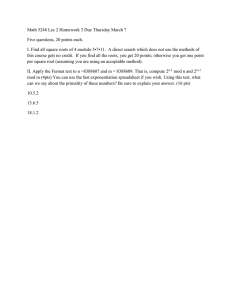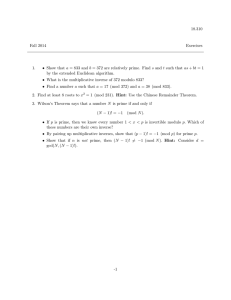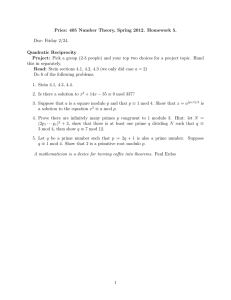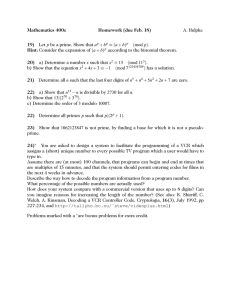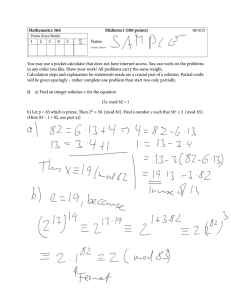Unit group structure
advertisement
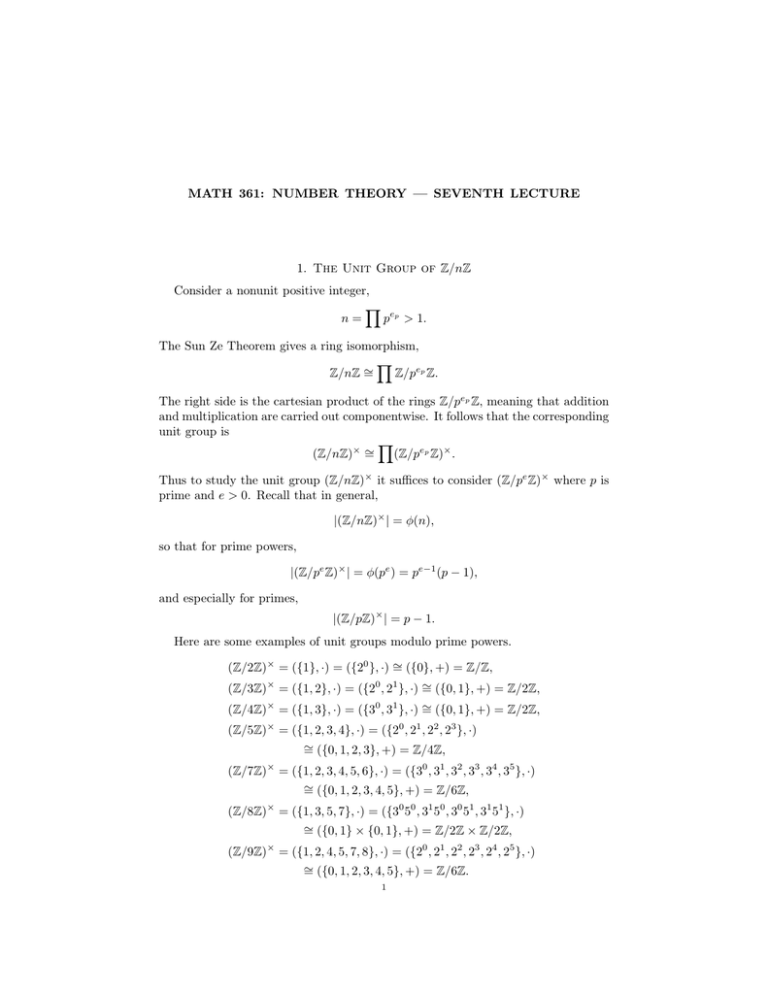
MATH 361: NUMBER THEORY — SEVENTH LECTURE
1. The Unit Group of Z/nZ
Consider a nonunit positive integer,
Y
n=
pep > 1.
The Sun Ze Theorem gives a ring isomorphism,
Y
Z/pep Z.
Z/nZ ∼
=
The right side is the cartesian product of the rings Z/pep Z, meaning that addition
and multiplication are carried out componentwise. It follows that the corresponding
unit group is
Y
(Z/pep Z)× .
(Z/nZ)× ∼
=
Thus to study the unit group (Z/nZ)× it suffices to consider (Z/pe Z)× where p is
prime and e > 0. Recall that in general,
|(Z/nZ)× | = φ(n),
so that for prime powers,
|(Z/pe Z)× | = φ(pe ) = pe−1 (p − 1),
and especially for primes,
|(Z/pZ)× | = p − 1.
Here are some examples of unit groups modulo prime powers.
(Z/2Z)× = ({1}, ·) = ({20 }, ·) ∼
= ({0}, +) = Z/Z,
(Z/3Z)× = ({1, 2}, ·) = ({20 , 21 }, ·) ∼
= ({0, 1}, +) = Z/2Z,
(Z/4Z)× = ({1, 3}, ·) = ({30 , 31 }, ·) ∼
= ({0, 1}, +) = Z/2Z,
(Z/5Z)× = ({1, 2, 3, 4}, ·) = ({20 , 21 , 22 , 23 }, ·)
∼
= ({0, 1, 2, 3}, +) = Z/4Z,
(Z/7Z)× = ({1, 2, 3, 4, 5, 6}, ·) = ({30 , 31 , 32 , 33 , 34 , 35 }, ·)
∼
= ({0, 1, 2, 3, 4, 5}, +) = Z/6Z,
(Z/8Z)× = ({1, 3, 5, 7}, ·) = ({30 50 , 31 50 , 30 51 , 31 51 }, ·)
∼
= ({0, 1} × {0, 1}, +) = Z/2Z × Z/2Z,
(Z/9Z)× = ({1, 2, 4, 5, 7, 8}, ·) = ({20 , 21 , 22 , 23 , 24 , 25 }, ·)
∼
= ({0, 1, 2, 3, 4, 5}, +) = Z/6Z.
1
2
MATH 361: NUMBER THEORY — SEVENTH LECTURE
2. Prime Unit Group Structure: Abelian Group Theory Argument
Proposition 2.1. Let G be any finite subgroup of the unit group of any field. Then
G is cyclic. In particular, the multiplicative group modulo any prime p is cyclic,
(Z/pZ)× ∼
= Z/(p − 1)Z.
That is, there is a generator g mod p such that
(Z/pZ)× = {1, g, g 2 , . . . , g p−2 }.
Proof. We may assume that G is not trivial. By the structure theorem for finitely
generated abelian groups,
(G, ·) ∼
= (Z/d1 Z × Z/d2 Z × · · · × Z/dk Z, +),
k ≥ 1, 1 < d1 | d2 · · · | dk .
Thus the polynomial equation X dk = 1, whose additive counterpart is dk X = 0, is
satisfied by each of the d1 d2 · · · dk elements of G; but also, the polynomial has at
most as many roots as its degree dk . Thus k = 1 and G is cyclic.
The proof tacitly relies on a fact from basic algebra:
Lemma 2.2. Let k be a field. Let f ∈ k[X] be a nonzero polynomial, and let d
denote its degree (thus d ≥ 0). Then f has at most d roots in k.
Proof. If f has no roots then we are done. Otherwise let a ∈ k be a root. Write
f (X) = q(X)(X − a) + r(X),
deg(r) < 1 or r = 0.
Thus r(X) is a constant. Substitute a for X to see that in fact r = 0, and so
f (X) = q(X)(X − a). By induction, q has at most d − 1 roots in k and we are
done.
The lemma does require that k be a field, not merely a ring. For example, the
polynomial X 2 − 1 over the ring Z/24Z has for its roots
{1, 5, 7, 11, 13, 17, 19, 23} = (Z/24Z)× .
To count the generators of (Z/pZ)× , consider any finite cyclic abelian group,
G∼
= Z/nZ.
For any integer k the subgroup of Z/nZ generated by k + nZ is
hk + nZi = kZ + nZ = gcd(k, n)Z + nZ = hgcd(k, n) + nZi,
which clearly has order n/ gcd(k, n). Especially, each k + nZ where k is coprime
to n generates the full group, and there are φ(n) such values of k. In particular,
(Z/pZ)× has φ(p − 1) generators.
3. Prime Unit Group Structure: Elementary Argument
From above, a nonzero polynomial over Z/pZ can not have more roots than its
degree. On the other hand, Fermat’s Little Theorem says that the polynomial
f (X) = X p−1 − 1 ∈ (Z/pZ)[X]
has a full contingent of p − 1 roots in Z/pZ.
MATH 361: NUMBER THEORY — SEVENTH LECTURE
3
For any divisor d of p − 1, consider the factorization (in consequence of the finite
geometric sum formula)
p−1
d −1
f (X) = X
p−1
d
− 1 = (X − 1)
X
call
X id = g(X)h(X).
i=0
We know that
• f has p − 1 roots in Z/pZ,
• g has at most d roots in Z/pZ,
• h has at most p − 1 − d roots in Z/pZ.
It follows that g(X) = X d − 1 where d | p − 1 has d roots in Z/pZ.
Now factor p − 1,
Y
p−1=
q eq .
For each factor q e of p − 1,
e
Xq − 1
Xq
e−1
has q e roots in Z/pZ,
−1
has q e−1 roots in Z/pZ,
and so (Z/pZ)× contains q e − q e−1 = φ(q e ) elements xq of order q e . (The order of
an element is the smallest positive number of times that the element is multiplied
by itself to give 1.) Plausibly,
Y
Y
any product
xq has order
q eq = p − 1,
q
q
and certainly there are φ(p − 1) such products. In sum, we have done most of the
work of showing
Proposition 3.1. Let p be prime. Then (Z/pZ)× is cyclic, with φ(p−1) generators.
The loose end is as follows.
Lemma 3.2. In a commutative group, consider two elements whose orders are
coprime. Then the order of their product is the product of their orders.
Proof. We have ae = bf = 1, and so
(ab)ef = (ae )f (bf )e = 1f 1e = 1.
Also we have (e, f ) = 1. So for any positive integer d,
e
(ab)d = 1 =⇒ 1 = (ab)d = (ae be )d = bed =⇒ f | ed =⇒ f | d,
and symmetrically e | d. Thus ef | d
4. Odd Prime Power Unit Group Structure: p-Adic Argument
Proposition 4.1. Let p be an odd prime, and let e be any positive integer. The
multiplicative group modulo pe is cyclic.
Proof. We have the result for e = 1, so take e ≥ 2. The structure theorem for
finitely generated abelian groups and then the Sun Ze theorem combine to show
that (Z/pe Z)× takes the form
(Z/pe Z)× = Ape−1 × Ap−1
(where An denotes an abelian group of order n).
By the Sun Ze Theorem, it suffices to show that each of Ape−1 and Ap−1 is cyclic.
4
MATH 361: NUMBER THEORY — SEVENTH LECTURE
The natural epimorphism (Z/pe Z)× −→ (Z/pZ)× maps Ape−1 to 1 in (Z/pZ)×
since the orders of the two groups are coprime but the image is a quotient of the
first and a subgroup of the second. Consequently the restriction of the natural
epimorphism to Ap−1 must be an isomorphism, and thus Ap−1 is cyclic because
(Z/pZ)× is. Furthermore, this discussion has shown that Ape−1 is the kernel of the
natural epimorphism,
Ape−1 = {a + pe Z : a = 1 mod p}.
Working p-adically, consider the group isomorphism
exp : pZp −→ 1 + pZp .
The exponential series converges on pZp because the summands decay notwithstanding the factorial in the denominator,
X n
(ap)n 1
p−2
νp
≥n−
n ≥ n, n ∈ Z≥0 .
=
n!
pi
p−1
2
i≥1
Similarly, the exponential map takes pe Zp into 1 + pe Zp . Indeed, the first two terms
of exp(ape ) for any a ∈ Zp are 1 + ape , and then for n ≥ 2,
νp
(ape )n 1 1
≥n e−
≥2 e−
= 2e − 1 > e.
n!
p−1
2
exp
Now we know that the surjective composition pZp −→ 1 + pe Zp −→ Ape−1 factors through pZp /pe Zp ≈ pZ/pe Z, with the resulting map pZ/pe Z −→ Ape−1 an
isomorphism because the two finite groups have the same order,
1 + pZp
Thus Ape−1 is cyclic, and the proof is complete.
∼
exp
/ / pZ/pe Z
∼
pZp
/ / Ape−1
The condition (p − 2)/(p − 1) > 0 in the proof fails for p = 2, but a modification
of the ideas here shows that (Z/2e Z)× has a cyclic subgroup of index 2.
Once one is aware that the truncated exponential series gives an isomorphism
∼
pZ/pe Z −→ Ape−1 , the isomorphism can be confirmed without direct reference
to the p-adic exponential. For example with e = 3, any px + p3 Z has image
1 + px + 21 p2 x2 + p3 Z, and similarly py + p3 Z has image 1 + py + 12 p2 y 2 + p3 Z; their
sum p(x + y) + p3 Z maps to 1 + p(x + y) + 12 p2 (x2 + 2xy + y 2 ) + p3 Z, which is also
the product of the images, even though 1 + p(x + y) + 12 p2 (x2 + 2xy + y 2 ) is not the
product of 1 + px + 21 p2 x2 and 1 + py + 12 p2 y 2 . This idea underlies the elementary
argument to be given next.
5. Odd Prime Power Unit Group Structure: Elementary Argument
Again we show that for any odd prime p and any positive e, the group (Z/pe Z)×
is cyclic. Here the argument is elementary.
MATH 361: NUMBER THEORY — SEVENTH LECTURE
5
Proof. Let g generate (Z/pZ)× . Since
(g + p)p−1 = g p−1 + (p − 1)g p−2 p mod p2 6= g p−1 mod p2 ,
it follows that
g p−1 6= 1 mod p2
or
(g + p)p−1 6= 1 mod p2 .
So after replacing g with g + p if necessary, we may assume that g p−1 6= 1 mod p2 .
Thus we know that
g p−1 = 1 + k1 p, p - k1 .
By the Binomial Theorem,
p−1 X
p j j
p(p−1)
p
g
= (1 + k1 p) = 1 + pk1 p +
k1 p + k1p pp
j
j=2
= 1 + k2 p2 ,
p - k2 .
The last equality holds because the terms in the sum and the term k1p pp are multiples
of p3 . (Here it is relevant that p > 2. The assertion fails for p = 2, g = 3 because of
the last term. That is, 32−1 = 1 + 1 · 2 so that k1 = 1 is not divisible by p = 2, but
then 32(2−1) = 9 = 1 + 2 · 22 so that k2 = 2 is.) Again by the Binomial Theorem,
p X
p j 2j
p2 (p−1)
2 p
2
g
= (1 + k2 p ) = 1 + pk2 p +
k p
j 2
j=2
= 1 + k3 p3 ,
p - k3 ,
because the terms in the sum are multiples of p4 . Similarly
3
gp
(p−1)
= 1 + k4 p4 ,
p - k4 ,
and so on, up to
gp
e−2
(p−1)
= 1 + ke−1 pe−1 ,
p - ke−1 .
That is,
e−2
g p (p−1) 6= 1 mod pe .
The order of g in (Z/pe Z)× must divide φ(pe ) = pe−1 (p − 1). If the order takes
the form pε d where ε ≤ e − 1 and d is a proper divisor of p − 1 then Fermat’s Little
Theorem (g p = g mod p) shows that the relation
gp
ε
d
= 1 mod pe
reduces modulo p to
g d = 1 mod p.
But this contradicts the fact that g is a generator modulo p. Thus the order of g
in (Z/pe Z)× takes the form pε (p − 1) where ε ≤ e − 1. The calculation above has
shown that ε = e − 1, and the proof is complete.
For example, 2 generates (Z/5Z)× , and 25−1 = 16 6= 1 mod 52 , so in fact 2
generates (Z/5e Z)× for all e ≥ 1.
A small consequence of the proposition is that since (Z/pe Z)× is cyclic for odd p,
and since φ(pe ) = pe−1 (p − 1) is even, the equation
x2 = 1 mod pe
has two solutions: 1 and g φ(p
e
)/2
.
6
MATH 361: NUMBER THEORY — SEVENTH LECTURE
6. Powers of 2 Unit Group Structure
Proposition 6.1. The structure of the unit group (Z/2e Z)× is
if e = 1,
Z/Z
e
× ∼
(Z/2 Z) = Z/2Z
if e = 2,
e−2
(Z/2Z) × (Z/2 Z) if e ≥ 3.
Specifically, (Z/2Z)× = {1}, (Z/4Z)× = {1, 3}, and for e ≥ 3,
e−2
(Z/2e Z)× ∼
= {±1} × {1, 5, 52 , . . . , 52 −1 }.
Proof. The results for (Z/2Z)× and for (Z/4Z)× are readily observable, and so we
take e ≥ 3.
Since |(Z/2e Z)× | = φ(2e ) = 2e−1 , we need to show that
e−3
52
e−2
6= 1 mod 2e ,
52
= 1 mod 2e ,
Similarly, to the previous argument, start from
0
52 = 5 = 1 + k2 22 ,
2 - k2 ,
and thus
1
52 = 52 = 1 + 2k2 22 + k22 24 = 1 + k3 23 ,
2 - k3 ,
and then
2
52 = 54 = 1 + 2k3 23 + k32 26 = 1 + k4 24 ,
2 - k4 ,
and so on up to
52
e−3
= 1 + ke−1 2e−1 ,
2 - ke−1 ,
and finally
52
e−2
= 1 + ke 2e ,
2 - ke .
The last two displays show that
e−3
52
6= 1 mod 2e ,
e−2
52
= 1 mod 2e .
That is, 5 generates half of (Z/2e Z)× . To show that the full group is
e−2
(Z/2e Z)× ∼
= {±1} × {1, 5, 52 , . . . , 52 −1 },
suppose that
(−1)a 5b = (−1)c 5d mod 2e ,
a, c ∈ {0, 1}, b, d ∈ {0, · · · , 2e−2 − 1}.
Inspect modulo 4 to see that c = a. So now 5b = 5d mod 2e , and the restrictions
on b and d show that d = b as well.
The group (Z/2e Z)× is not cyclic for e ≥ 3 because all of its elements have order
dividing 2e−2 .
The equation
x2 = 1 mod 2e
has one solution if e = 1, two solutions if e = 2, and four solutions if e ≥ 3,
(1, 1),
(−1, 1),
(1, 52
e−3
),
(−1, 52
e−3
).
MATH 361: NUMBER THEORY — SEVENTH LECTURE
7
With this information in hand, the Sun Ze Theorem shows that the number of
solutions of the equation
g
Y
x2 = 1 mod n,
(where n = 2e
pei i )
i=1
is
g
2
2 · 2g
4 · 2g
if e = 0, 1,
if e = 2,
if e ≥ 3.
For example, if n = 120 = 23 · 3 · 5 then the
Qgnumber of solutions is 16.
Especially, the fact that for odd n = i=1 pei i there are 2g − 1 proper square
roots of 1 modulo n has to do with the effectiveness of the Miller–Rabin primality
test. Recall that the test makes use of a diagnostic base b ∈ {1, . . . , n − 1} and of
the factorization n − 1 = 2s m, computing (everything modulo n)
bm ,
(bm )2 ,
((bm )2 )2 ,
...,
s−2
(bm2
)2 = bn−1 .
Of course, if bm = 1 then all the squaring is doing nothing, while if bn−1 6= 1 then
n is not prime by Fermat’s Little Theorem. The interesting case is when bm 6= 1
but bn−1 = 1, so that repeatedly squaring bm does give 1: in this case, squaring bm
one fewer time gives a proper square root of 1. If n has g distinct prime factors
then we expect this square root to be −1 only 1/(2g − 1) of the time. Thus, if
the process turns up the square root −1 for many values of b then almost certainly
g = 1, i.e., n is a prime power. Of course, if n is a prime power but not prime
then we hope that it isn’t a Fermat pseudoprime base b for many bases b, and the
Miller–Rabin will diagnose this.
7. Cyclic Unit Groups (Z/nZ)×
Consider a positive nonunit integer
n=
Y
pei i .
i
Recall the multiplicative component of the Sun Ze Theorem,
Y
∼
(Z/nZ)× −→
(Z/pep Z)× ,
a mod n 7−→ (a mod pe11 , · · · , a mod pekk ).
Consequently, the order of a divides the least common multiple of the orders of the
multiplicand-groups,
lcm{φ(pe11 ), · · · , φ(pekk )},
and thus a can not conceivably have order φ(n) unless all of the φ(pei i ) are coprime.
For each odd p, the totient φ(pe ) is even for all e ≥ 1. So for (Z/nZ)× to be
cyclic, n can have at most one odd prime divisor. Also, 2 | φ(2e ) for all e ≥ 2. So
the possible unit groups (Z/nZ)× that could be cyclic are
(Z/2Z)× ,
(Z/4Z)× ,
(Z/pe Z)× ,
(Z/2pe Z)× .
We know that the first three groups in fact are cyclic. For n = 2pe , the Sun Ze
Theorem gives
(Z/2pe Z)× ∼
= (Z/2Z)× × (Z/pe Z)× ∼
= (Z/pe Z)× ,
showing that the fourth group is cyclic as well. If g generates (Z/pe Z)× then
whichever of g and g + pe is odd generates (Z/2pe Z)× .
